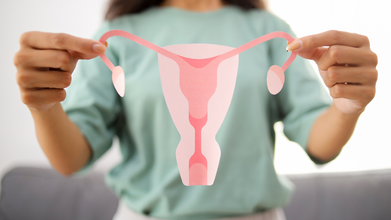- Health Conditions A-Z
- Health & Wellness
- Nutrition
- Fitness
- Health News
- Ayurveda
- Videos
- Medicine A-Z
- Parenting
- Web Stories
Should You Wash Your Face With Salt Water?

Credit: Canva
In the realm of skincare, home remedies have long been a go-to for many, and one such trend gaining popularity is washing the face with salt water. From acne reduction to skin detoxification, the humble salt solution is being praised on social media. But does it really live up to the hype? And more importantly, is it safe for everyday use?
Salt water, particularly when derived from natural sea water, contains minerals like magnesium, calcium, and potassium. These elements are known for their antibacterial and anti-inflammatory properties. This is one reason why a dip in the ocean often leaves the skin feeling refreshed and rejuvenated. Some people replicate this effect at home by mixing sea salt with warm water and using it as a facial rinse.
Dermatologists agree that salt water does have certain benefits—when used in moderation. “Salt water can help cleanse the skin, reduce oiliness, and calm mild inflammation,” says Dr. Nisha Verma, a Mumbai-based dermatologist. “It can be particularly useful for people with acne-prone or oily skin because salt has natural antiseptic properties that can help reduce bacteria and unclog pores.”
However, experts caution against daily use or using high concentrations of salt. Salt is a natural dehydrator—it draws water out of cells. This means overuse can strip the skin of its natural moisture, leading to dryness, irritation, or even flaking. People with dry, sensitive, or eczema-prone skin are especially advised to steer clear of salt-based treatments unless under medical supervision.
In a controlled routine, salt water can be used as a toner or rinse a few times a week. The solution should be mild—usually one teaspoon of sea salt dissolved in half a cup of warm water. After application, it's crucial to moisturize to restore the skin’s hydration barrier.
Anecdotal reports also suggest that salt water may help reduce blackheads and tighten pores, but these claims lack solid scientific backing. “Most of the positive effects are temporary,” says Dr. Verma. “It’s not a substitute for a good skincare routine or prescribed treatment for chronic conditions like acne or rosacea.”
There’s also a growing trend of using Himalayan pink salt or Dead Sea salt for their mineral content. While these may offer a slight edge due to their rich composition, the core principles remain the same—moderation and proper dilution are key.
For those with skin infections or open wounds, dermatologists strongly discourage the use of salt water. It may sting and irritate the area, delaying healing. Similarly, those undergoing treatments like chemical peels or retinol-based regimens should avoid salt rinses as it can lead to increased sensitivity.
In conclusion, while washing your face with salt water may offer certain skin benefits, it is not a one-size-fits-all solution. Used correctly, it can be a helpful occasional addition to your skincare regimen—but relying on it daily or overusing it could do more harm than good.
As always, consult a dermatologist before incorporating any new treatment into your routine—especially one that could affect your skin’s natural barrier.
COVID Cases Drop, But Doctors Are Seeing More Patients With THIS Respiratory Issue

Credits: Canva
It has been five years since COVID first appeared, and over this period, case numbers have both surged and declined. Suruchi Sood, an assistant professor at Johns Hopkins University in Baltimore, notes that some delays in COVID tracking by the Centers for Disease Control are partly due to the government shutdown. Based on the available data and her own clinical observations, she says, “We don’t seem to be seeing, thankfully, yet, an uptick of COVID.” However, she points out that another respiratory illness is currently gaining ground in the country.
Not Covid, But This Disease Is Spreading
Although COVID-19 cases are declining, many people are still experiencing congestion and sore throats. Dr. Steven Gordon, chairman of the Department of Infectious Disease at the Cleveland Clinic, noted that recent lab data from Northeast Ohio show SARS-CoV-2 activity continuing to fall from its summer peak, with last week’s COVID positivity rate at 5%.
At the same time, infections caused by rhinovirus, the common cold virus, and other enteroviruses have been rising, with a 20% positivity rate. While these numbers are specific to Northeast Ohio, they reflect broader trends reported by the CDC, which show increasing rhinovirus and enterovirus cases as of late September.
What Is Rhinovirus?
Rhinovirus is a widespread virus and the leading cause of the common cold, though it can also trigger other respiratory conditions such as asthma flare-ups, bronchitis, and pneumonia. It spreads through respiratory droplets, direct contact, or contaminated surfaces. While it usually affects the upper respiratory tract, it can sometimes cause infections in the lower respiratory system.
How Does Rhinovirus Spread?
Rhinovirus spreads in several ways, according to the CDC. It can be transmitted through respiratory droplets released when an infected person coughs, sneezes, or talks. The virus can also pass through direct person-to-person contact. In addition, rhinovirus can survive on surfaces such as doorknobs, phones, or other objects for several days, allowing it to spread when someone touches these contaminated surfaces.
How To Stay Safe From Rhinovirus?
As we approach the virus season, it’s important to take steps to protect your health, experts say. Dr. Steven Gordon emphasizes that prevention is better than treatment, recommending the flu shot for anyone older than six months as the most effective protection against influenza. Similarly, getting the COVID-19 vaccine remains the best way to reduce the risk of severe illness and hospitalization.
“With COVID and flu vaccines available, now is an ideal time to get vaccinated, as it takes several weeks for immunity to build,” said Dr. Suruchi Sood. Both vaccines can be administered at the same time and are widely available at pharmacies. It’s advisable to check with your doctor or local pharmacy about COVID shot eligibility in your area.
Maintaining overall health through regular exercise and a nutritious diet can also help defend against respiratory viruses, while frequent handwashing remains a simple but effective preventive measure. COVID vaccination continues to be a safe and effective way to lessen the severity of illness, with recent studies in the VA Health System showing that it reduced hospitalizations, deaths, and emergency visits even in the past season, Dr. Sood added.
Ozempic And Wegovy Users Are Reporting A Growing ‘Unusual’ Side Effect, Study Finds

Credits: Canva
A recently published study has drawn attention to a new and rather unexpected side effect linked to popular weight-loss medications.
Drugs such as Ozempic and Wegovy, originally developed for type 2 diabetes but now widely used for weight management, have seen a sharp rise in demand. A Kaiser Family Foundation survey released in May 2024 found that roughly one in eight American adults has used a GLP-1 drug.
However, as their use becomes more widespread, doctors are identifying additional side effects, one of which may complicate the results of certain medical scans.
Ozempic And Wegovy Users Are Reporting A Growing ‘Unusual’ Side Effect
Researchers at Alliance Medical, a European imaging services company, examined PET-CT scans of cancer patients who were using GLP-1 medications. In this type of scan, a patient is given an intravenous injection of a radioactive sugar compound called fluorodeoxyglucose (FDG). Because diseased cells consume more of the substance than healthy ones, the PET scanner highlights these areas as “hot spots,” as described by the Cleveland Clinic.
Often, PET and CT scans are done together, the CT providing X-ray–based images that, when combined with PET data, give doctors a detailed 3D view of the body.
According to findings presented in September at the Annual Congress of the European Association of Nuclear Medicine, Alliance Medical researchers observed several abnormal FDG uptake patterns among patients using GLP-1 drugs. These irregularities could easily be mistaken for signs of disease if physicians are unaware of the patient’s medication use.
“We first saw an unexpected uptake pattern in one patient taking a GLP-1 agonist, which led us to conduct a broader review across our centers,” said Dr. Peter Strouhal, Medical Director at Alliance Medical, in a statement shared by the American Association for the Advancement of Science.
If these scans are read incorrectly, patients could face unnecessary diagnostic procedures, inaccurate cancer staging, and potential delays in receiving the right treatment.
Other Side Effects Of Weight Loss Drugs
Many people who use GLP-1 medications experience digestive discomfort such as nausea, vomiting, constipation, diarrhea, or heartburn. The drugs are also known to carry risks like gallbladder disease, bone fractures, and, in some cases, pancreatitis.
Recently, however, new physical changes popularly referred to as “Ozempic vulva” and “Ozempic breasts” have begun drawing attention. Across social media, women have described noticeable changes since starting these injections, including sagging skin, vaginal dryness, weakened pelvic muscles, and occasionally an increase in discharge.
Though vaginal changes are not listed among the official side effects of GLP-1 drugs, specialists believe they may be connected to the rapid fat loss these medications cause. As body fat decreases, the natural fat pads that cushion and support vulvar tissue can diminish, leading to visible and functional changes.
“Ozempic breasts” is a term used to describe changes in breast size or shape that occur after significant weight loss from GLP-1 medications such as Ozempic and Wegovy. Many women report reduced volume, increased sagging, and, in some cases, tenderness as their body fat percentage drops.
THIS Common Hormone Condition Is The Most Misdiagnosed In Women

Credits: Canva
Scrolling through social media, many women encounter stories of celebrities describing years of unexplained symptoms before receiving a diagnosis of polycystic ovary syndrome (PCOS). Model and actress Lori Harvey recently shared her experience with weight fluctuations, acne, facial hair growth, and painful irregular periods, highlighting a common struggle among women of reproductive age. Stories like hers resonate with women like Alexis King, who found validation in hearing someone else’s journey, as reported in Washington Post.
PCOS is a hormone disorder affecting roughly one in ten women worldwide, including about six million Americans. It is linked to both reproductive and metabolic dysfunction, increasing the risk of fertility problems as well as chronic conditions such as high blood pressure, diabetes, obesity, and cardiovascular disease. Despite its prevalence, PCOS remains underfunded and under-recognized, leaving many women to navigate the condition largely on their own.
A “Silent” Diagnosis
For many, PCOS is identified only after years of unexplained symptoms. Patients often encounter healthcare providers who focus on cosmetic solutions rather than addressing the underlying hormonal imbalance. Researchers note that PCOS is considered an “orphan disorder” in women’s health, receiving significantly less funding than conditions with comparable prevalence and severity. From 2016 to 2022, average annual funding for PCOS was around $32 million, compared with $262 million for rheumatoid arthritis and $66 million for tuberculosis, according to recent studies reported in Washington Post.
Experts stress the need for comprehensive management rather than relying on individual supplements, though some, such as inositol, have shown promise in improving metabolic and reproductive outcomes. There is no cure or FDA-approved treatment specifically for PCOS, though existing interventions can alleviate symptoms and reduce long-term health risks, according to Richard Legro, chair of obstetrics and gynecology at Penn State Health Milton S. Hershey Medical Center, as reported in Washington Post.
Challenges in Diagnosis
A full PCOS diagnosis requires meeting at least two of three criteria: irregular periods, elevated male hormones, or ovaries with fluid-filled sacs visible on ultrasound. Yet many patients never undergo complete hormone testing or imaging, leaving the disorder undiagnosed for years. Clinicians often lack training to treat PCOS effectively, as it spans multiple specialties, from reproductive endocrinology to general gynecology. Multidisciplinary clinics exist but are limited in number, forcing patients to seek care from providers unfamiliar with the full scope of the disorder, as reported in Washington Post.
Delayed diagnosis can have serious consequences. Women with PCOS face increased risks of infertility, pregnancy complications, and chronic conditions. Endometrial cancer risk is higher due to irregular shedding of the uterine lining, and Black women experience disproportionately higher rates of adverse outcomes due to later diagnosis and barriers to care.
Research and Emerging Treatments
In the absence of robust funding, clinicians have relied on medications such as metformin, which improves insulin sensitivity, to manage PCOS symptoms. Research is also exploring the use of weight-loss drugs, such as semaglutide, to regulate hormone levels, restore periods, and reduce metabolic risks. Early trials show promise, with participants reporting restored menstrual cycles, improved hormone balance, and weight loss, as reported in Washington Post.
Despite these advances, insurance coverage remains a challenge. Patients often must pay out of pocket for medications that are not yet FDA-approved specifically for PCOS. Researchers like Melanie Cree, a pediatric endocrinologist, are pushing for standardized testing and more clinical trials, but funding delays and reduced philanthropic support continue to slow progress.
As awareness grows, advocates and researchers aim to prioritize PCOS as a significant public health concern, emphasizing early detection, comprehensive treatment, and equitable access to care. For millions of women, improved understanding and treatment of PCOS could transform lives, reducing both immediate discomfort and long-term health risks, as reported in Washington Post.
© 2024 Bennett, Coleman & Company Limited

